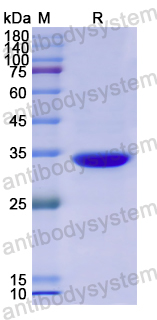Catalog No.
YHH87101
Expression system
E. coli
Species
Homo sapiens (Human)
Protein length
Gln189-Lys464
Predicted molecular weight
34.83 kDa
Nature
Recombinant
Endotoxin level
Please contact with the lab for this information.
Purity
>90% as determined by SDS-PAGE.
Accession
Q53EZ4
Applications
ELISA, Immunogen, SDS-PAGE, WB, Bioactivity testing in progress
Form
Lyophilized
Storage buffer
Lyophilized from a solution in PBS pH 7.4, 0.02% NLS, 1mM EDTA, 4% Trehalose, 1% Mannitol.
Reconstitution
Reconstitute in sterile water for a stock solution. A copy of datasheet will be provided with the products, please refer to it for details.
Shipping
In general, proteins are provided as lyophilized powder/frozen liquid. They are shipped out with dry ice/blue ice unless customers require otherwise.
Stability and Storage
Use a manual defrost freezer and avoid repeated freeze thaw cycles. Store at 2 to 8°C for frequent use. Store at -20 to -80°C for twelve months from the date of receipt.
Alternative Names
Centrosomal protein of 55 kDa, Cep55, C10orf3, CEP55, Up-regulated in colon cancer 6, URCC6
Cancer/testis antigens FBXO39 and CEP55 expression correlates with survival in GBM patients., PMID:40504854
Investigating the Genetic Links Between Immune Cell Profiles and Bladder Cancer: A Multidisciplinary Bioinformatics Approach., PMID:40427030
Identification and validation of shared biomarkers and drug repurposing in psoriasis and Crohn's disease: integrating bioinformatics, machine learning, and experimental approaches., PMID:40406126
CEP55 as a prognostic indicator and a predictive marker in oral squamous cell carcinoma., PMID:40386043
A comprehensive review and in silico analysis of the role of survivin (BIRC5) in hepatocellular carcinoma hallmarks: A step toward precision., PMID:40306500
UBTD2 protein molecules emerges as a key prognostic protein marker in glioma: Insights from integrated omics and machine learning analysis of GRM7, NCAPG, CEP55, and other biomarkers., PMID:40286967
CEP55, A Promising Prognostic Biomarker for Pancreatic Neuroendocrine Neoplasms, Promotes Tumor Progression Through Activation of PI3K/AKT/mTOR Pathway., PMID:40249668
iMLGAM: Integrated Machine Learning and Genetic Algorithm-driven Multiomics analysis for pan-cancer immunotherapy response prediction., PMID:40236779
NEMO Family of Proteins as Polyubiquitin Receptors: Illustrating Non-Degradative Polyubiquitination's Roles in Health and Disease., PMID:39996775
Mechanism of Centrosomal Protein 55 (CEP55) Loading Into Exosomes., PMID:39976236
Single-cell and machine learning approaches uncover intrinsic immune-evasion genes in the prognosis of hepatocellular carcinoma., PMID:39958919
Integrative Bioinformatics Analysis for Targeting Hub Genes in Hepatocellular Carcinoma Treatment., PMID:39911278
RNA binding protein ILF3 increases CEP55 mRNA stability to enhance malignant potential of breast cancer cells and suppress ferroptosis., PMID:39871389
An Integrated Framework to Identify Prognostic Biomarkers and Novel Therapeutic Targets in Hepatocellular Carcinoma-Based Disabilities., PMID:39765633
Pan-cancer analysis of oncogenic role of CEP55 and experiment validation in clear cell renal cell carcinoma., PMID:39550427
ALKBH5 activates CEP55 transcription through m6A demethylation in FOXP2 mRNA and expedites cell cycle entry and EMT in ovarian cancer., PMID:39511642
Biallelic missense CEP55 variants cause prenatal MARCH syndrome., PMID:39414989
Exploring common pathogenic association between Epstein Barr virus infection and long-COVID by integrating RNA-Seq and molecular dynamics simulations., PMID:39391317
Primary Sjogren's Syndrome Associated with Lung Adenocarcinoma: Probing the Potential Common Pathogenic Mechanisms and Experimental Verification., PMID:39373505
Integrated bioinformatic analysis reveals the gene signatures, epigenetic roles, and regulatory networks in endometriosis., PMID:39306912
Ailanthone suppresses cell proliferation of renal cell carcinoma partially via inhibition of EZH2., PMID:39298003
Identification of Hub Genes in Comorbidity of Psoriasis and Vitiligo Using Bioinformatics Analysis., PMID:39258216
On discovery of novel hub genes for ER+ and TN breast cancer types through RNA seq data analyses and classification models., PMID:39242688
SPI1-mediated transcriptional activation of CEP55 promotes the malignant growth of triple-negative breast cancer and M2 macrophage polarization., PMID:39197215
Centrosomal Protein 55 Regulates Chromosomal Instability in Cancer Cells by Controlling Microtubule Dynamics., PMID:39195269
N6-methyladenosine-mediated LINC01087 promotes lung adenocarcinoma progression by regulating miR-514a-3p to upregulate centrosome protein 55., PMID:39023191
The prognostic value of immune escape-related genes in lung adenocarcinoma., PMID:38988926
CEP55: Implications for Immunotherapy and Survival in Hepatocellular Carcinoma., PMID:38847172
The Features of Shared Genes among Transcriptomes Probed in Atopic Dermatitis, Psoriasis, and Inflammatory Acne: S100A9 Selection as the Target Gene., PMID:38766834
Molecular Pathogenic Mechanisms of IgA Nephropathy Secondary to COVID-19 mRNA Vaccination., PMID:38301615
Prognostic and predictive value of super-enhancer-derived signatures for survival and lung metastasis in osteosarcoma., PMID:38254188
Centrosomal Protein 55 (CEP55) Drives Immune Exclusion and Resistance to Immune Checkpoint Inhibitors in Colorectal Cancer., PMID:38250876
Identification of potential key genes for colorectal cancer based on bioinformatics analysis., PMID:38134110
Exploration and validation of a combined Hypoxia and m6A/m5C/m1A regulated gene signature for prognosis prediction of liver cancer., PMID:38097948
Prognostic hub gene CBX2 drives a cancer stem cell-like phenotype in HCC revealed by multi-omics and multi-cohorts., PMID:37980163
The role of midbody-associated mRNAs in regulating abscission., PMID:37922419
CEP55 as a Promising Immune Intervention Marker to Regulate Tumor Progression: A Pan-Cancer Analysis with Experimental Verification., PMID:37887301
Advanced stage, high-grade primary tumor ovarian cancer: a multi-omics dissection and biomarker prediction process., PMID:37828118
SYT7 is a key player in increasing exosome secretion and promoting angiogenesis in non-small-cell lung cancer., PMID:37774826
Upregulation of the key biomarker kinesin family member 20A (KIF20A) is associated with pulmonary artery hypertension., PMID:37703933
Amorphous silica nanoparticles cause abnormal cytokinesis and multinucleation through dysfunction of the centralspindlin complex and microfilaments., PMID:37608338
CEACAM1 as a molecular target in oral cancer., PMID:37589542
Identification of survival-associated biomarkers based on three datasets by bioinformatics analysis in gastric cancer., PMID:37584004
Cancer-testis antigen CEP55 serves as a prognostic biomarker and is correlated with immune infiltration and immunotherapy efficacy in pan-cancer., PMID:37484531
Important roles of Hif1a in maternal or adult BPA exposure induced pancreatic injuries., PMID:37460698
UMAD1 contributes to ESCRT-III dynamic subunit turnover during cytokinetic abscission., PMID:37439191
Inhibition mechanism of testis-expressed gene 14 (TEX14) in cytokinetic abscission: Well-tempered metadynamics simulation studies., PMID:37409705
α-catenin interaction with YAP/FoxM1/TEAD-induced CEP55 supports liver cancer cell migration., PMID:37381005
Identification of key biomarkers and related immune cell infiltration in cervical cancer tissue based on bioinformatics analysis., PMID:37344577
Macrophage-derived exosomal miR-342-3p promotes the progression of renal cell carcinoma through the NEDD4L/CEP55 axis., PMID:37305161

